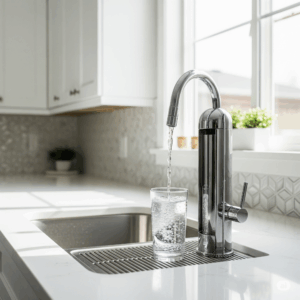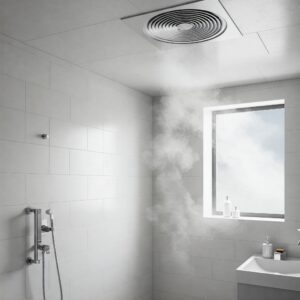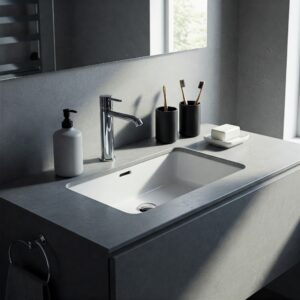The bathroom is our personal sanctuary for hygiene, relaxation, and rejuvenation. However, the quality of the water we use daily for showering, bathing, and washing can significantly impact our skin, hair, bathroom fixtures, and overall well-being. Tap water, even if municipally treated, can contain chlorine, hard water minerals, sediment, and other impurities that lead to dryness, irritation, dull hair, and unsightly buildup. In regions like Indonesia, water quality can vary greatly, with humidity exacerbating issues like soap scum and mineral deposits. Bathroom water filtration systems offer targeted solutions to improve the water you bathe in, leading to a noticeably better experience.
This article explores why filtering your bathroom water is beneficial, the types of systems available, common filtration media, and how to choose the right option for your home.
Why Filter Your Bathroom Water? (Benefits)
Investing in a bathroom water filter, whether a simple showerhead attachment or a comprehensive whole-house system, can offer many advantages:
- Softer, Healthier Skin: Reduces chlorine and hard water minerals (like calcium and magnesium) that can strip natural oils, leading to dryness, itchiness, and irritation. Filtered water can leave skin feeling smoother and less prone to conditions like eczema flares.
- Shinier, More Manageable Hair: Chlorine and hard water minerals can make hair dry, brittle, dull, and difficult to manage. Filtered water can result in softer, shinier hair and a healthier scalp. Color-treated hair may also retain its vibrancy longer.
- Reduced Irritation: Removing chlorine and other potential chemical irritants is especially beneficial for individuals with sensitive skin, allergies, or respiratory issues aggravated by chlorine vapor in steamy showers.
- Less Soap Scum & Scale Buildup: Filtering out hard water minerals significantly reduces the formation of unsightly soap scum on shower doors, tiles, and tubs, as well as limescale buildup on faucets and showerheads. This means less scrubbing and a cleaner-looking bathroom.
- Improved Lathering: Softened or chlorine-free water allows soaps, shampoos, and conditioners to lather more effectively, meaning you might even use less product.
- Reduced Chlorine Exposure: Minimizes both skin absorption and inhalation of chlorine and its byproducts (chloramines) during hot, steamy showers.
- Protection for Bathroom Fixtures: Reducing scale buildup can help prolong the life and maintain the appearance of your showerheads, faucets, and drains.
- A More Pleasant Bathing Experience: Water that feels softer and smells cleaner enhances the overall comfort and enjoyment of your shower or bath.
Common Water Issues Addressed by Bathroom Filters
While issues vary geographically, common concerns that bathroom filters target include:
- Chlorine: Widely used for municipal water disinfection, but it causes dryness, irritation, and an unpleasant odor/taste.
- Hard Water Minerals (Calcium & Magnesium): Responsible for limescale, soap scum, and can contribute to dry skin and dull hair. Water hardness is a significant issue in many parts of Indonesia.
- Sediment, Rust, and Particulates: Can come from older pipes or the water source itself, making water appear cloudy or discolored.
- Some Heavy Metals & VOCs: More comprehensive systems can reduce certain heavy metals or volatile organic compounds, though this is often a focus of whole-house systems.
Types of Bathroom Water Filtration Systems
Filtration options for the bathroom range from simple attachments to whole-home solutions:
- Showerhead Filters:
- How they work: These units typically screw directly onto your existing shower arm, replacing your current showerhead, or are an inline cartridge placed between the arm and your showerhead. They commonly use a combination of filter media like KDF, activated carbon, and calcium sulfite.
- Pros: Easy to install (usually no tools required), relatively affordable, targets water directly at the point of showering.
- Cons: Filter cartridges need regular replacement (typically every 3-6 months); effectiveness varies by brand and specific contaminants targeted; primarily reduces chlorine, some sediment, and improves feel – may not significantly soften very hard water.
- Inline Shower Filters / Bath Spout Filters:
- How they work: These are cartridge-based filters installed on the water line leading to the showerhead or the bath spout. They can be slightly larger than integrated showerhead filters.
- Pros: Can be more discreet than some bulky showerhead filters; potentially offer a slightly longer filter life or higher capacity for some models.
- Cons: Requires minor plumbing to install on the line; shares similar filtration capabilities and limitations to showerhead filters.
- Whole-House Water Filters (Point-of-Entry):
- How they work: These systems are installed on the main water line where water first enters your home, filtering all water distributed to every tap, including all bathrooms, kitchen, and laundry. Systems can range from simple sediment/carbon filters to more complex multi-stage units.
- Pros: Provides filtered water throughout the entire house, addressing issues comprehensively. Protects all plumbing and appliances.
- Cons: More expensive upfront cost, requires professional plumbing installation, filter replacement can be more involved and costly depending on the system size and type.
- Water Softeners (Typically Whole-House):
- How they work: Specifically designed to remove hardness minerals (calcium and magnesium) through an ion exchange process, typically using salt.
- Pros: Effectively eliminates problems associated with hard water: scale buildup, soap scum, improves soap lathering, leads to softer skin and hair.
- Cons: Does not filter other contaminants like chlorine or sediment (often used with a separate filter for these); traditional salt-based softeners add small amounts of sodium to the water and require periodic salt replenishment; some regions have restrictions on salt brine discharge. Salt-free “conditioners” exist, but their effectiveness is debated.
Common Filter Media Used in Bathroom Filters
- KDF (Kinetic Degradation Fluxion): A copper-zinc formulation that reduces chlorine, some heavy metals (like lead and mercury), and inhibits the growth of bacteria, fungi, and algae within the filter.
- Activated Carbon (Granular or Block): Highly effective at adsorbing chlorine, volatile organic compounds (VOCs), improving taste and odor.
- Calcium Sulfite: Particularly effective at removing chlorine in hot water, making it suitable for showers.
- Vitamin C (Ascorbic Acid): Used in some shower filters to neutralize chlorine and chloramine quickly.
- Sediment Filters: Polypropylene or other materials that physically trap sand, silt, rust, and other particles.
Choosing the Right Bathroom Water Filtration System
- Identify Your Primary Concerns: Is your main issue chlorine odor and dry skin? Or is it hard water scale buildup on fixtures and tiles? Or both?
- Assess Your Water Source & Quality: Municipally treated water will primarily have chlorine and potentially hardness. Well water can have a wider range of issues including sediment, hardness, iron, or even bacteria, requiring more comprehensive testing and filtration.
- Shower-Specific vs. Whole-House: If your concerns are limited to the shower experience, a good quality showerhead filter might suffice. If water quality issues affect your entire home (e.g., hard water damaging all appliances), a whole-house system is a better long-term solution.
- Budget: Consider both the initial purchase price and the ongoing cost and frequency of filter cartridge replacements.
- Installation: Showerhead filters are typically easy DIY. Inline and whole-house systems usually require professional plumbing.
- Filter Lifespan & Maintenance: How long do filters last, and how easy are they to replace?
- Space Availability: Especially for whole-house systems or under-sink components if considering a dedicated filter for a bathroom sink.
- Certifications: Look for filters certified by independent organizations like NSF International or WQA to verify contaminant reduction claims.
Conclusion
Investing in a bathroom water filtration system can significantly transform your daily bathing experience, leading to softer skin and hair, a cleaner bathroom with less scale and soap scum, and a more pleasant shower environment by reducing chlorine and other impurities. Whether you opt for a simple showerhead filter to tackle chlorine or a whole-house system to address widespread hard water or sediment issues, the “right” choice depends on your specific water quality problems, desired outcomes, and budget. By understanding the options and what they target, you can select a system that makes your bathroom a true haven for health and relaxation.







Leave a Comment